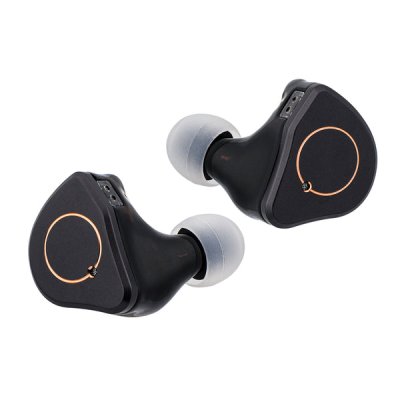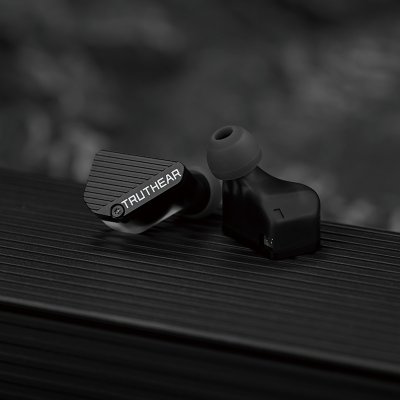Simgot Supermix 4 and Truthear Pure use 1DD+1BA+1Planar+1PZT and 1DD+3BA driver setups respectively. Simgot Supermix 4 costs $150 while Truthear Pure costs $90. Simgot Supermix 4 is $60 more expensive. Simgot Supermix 4 holds a clear 0.7-point edge in reviewer scores (6.9 vs 6.2). User ratings place Simgot Supermix 4 at 6 and Truthear Pure at 8.5. Simgot Supermix 4 has significantly better bass with a 1.2-point edge, Simgot Supermix 4 has better mids with a 0.8-point edge, Truthear Pure has slightly better treble with a 0.4-point edge, Truthear Pure has slightly better dynamics with a 0.4-point edge and Truthear Pure has better soundstage with a 0.6-point edge.
Insights
| Metric | Simgot Supermix 4 | Truthear Pure |
|---|---|---|
| Bass | 8 | 6.9 |
| Mids | 7 | 6.2 |
| Treble | 6.5 | 6.9 |
| Details | 6.9 | 6.6 |
| Soundstage | 6 | 6.6 |
| Imaging | 6.9 | 6.5 |
| Dynamics | 6 | 6.4 |
| Tonality | 6.7 | 6.4 |
| Technicalities | 7 | 6.3 |
Simgot Supermix 4 Aggregated Review Score
Average Reviewer Scores
Average Reviewer Score:
6.9Cautiously Favorable
Truthear Pure Aggregated Review Score
Average Reviewer Scores
Average Reviewer Score:
6.2Mixed to Positive
Reviews Comparison
Simgot Supermix 4 reviewed by Jays Audio
Youtube Video Summary
SIMGOT Supermix 4 comes out swinging: a quad-brid with both planar and PZT drivers that somehow sounds buttery smooth and shockingly coherent—more like a single driver than a parts bin. Upper-mids and treble sit neutral and refined, avoiding the usual glare; tuning reads as Harman 2019 done right—what feels like endgame Harman. Versus sets like Supernova/Nova/Chopin, the SM4 brings cleaner extension, higher resolving power, and a smoother, more polished treble where cymbals and consonants land naturally. Note this is a pre-production unit, so final tuning may still shift.
Bass quantity measures lower than some peers, but that puts the low end in the background and boosts separation, layering, and transient clarity; texture is tidy, impact respectable, and decay well-judged. Vocals are a highlight—accurate, balanced, complete in extension, and consistently non-fatiguing. Treble adds a sprinkle of liveliness without turning sharp. In A/Bs: it feels like a cleaner, more energetic Origin; a smoother, more technical all-rounder than CK LVX/Pula (though those keep a fuller, dreamier flavor); trades blows with Dusk (Dusk hits harder and runs brighter, SM4 wins mid/upper-mid detail and vocal completeness); and out-separates Hype 4 while Hype 4 remains the bigger, bassier fun pick. As an all-rounder this is top-tier; if priced around Dusk/Hype 4 it’s a strong value, while a ~$500 tag would push it into diminishing returns.
Jays Audio Youtube Channel
Buy Simgot Supermix 4 on Linsoul
Ad
Price: $149.99
Buy Simgot Supermix 4 on Linsoul
Truthear Pure reviewed by Jays Audio
Youtube Video Summary
Truthear Pure lands as the so-called Hexa successor, but the tuning pivots hard: it’s warmer, darker, and even more laid-back. Male vocals pop with weight, extension, and a lush low-end foundation. At mid-to-low volumes it can come off bloated and a little low-res up top, with dulled upper-mid/treble detail; push it to around 75 dB+ and it scales nicely, opening the stage, adding clarity, and staying non-fatiguing thanks to the tamer upper mids.
Genre pairing leans into hip-hop, rap, R&B, jazz, and rock/metal: there’s satisfying mid-bass impact and sub-bass rumble, with restrained upper mids keeping sibilance and shout in check on hotter recordings. Tipwise, avoid bass-boosters like Final E, Divinus Venus, and even the stock silicones. Go with Softears Ultra Clear or other clear, open-bore tips to nudge in more treble air while keeping the smoothness.
On raw technicals, Pure isn’t class-leading for its bracket—less detail and separation than the older Hexa despite sharing drivers, because the warmer/darker tilt trims perceived clarity. Buy it for the tuning and volume scaling. It plays like a more vocal-centric spin on the AFUL Explorer (darker, immersive, vocals pop more, a bit less sub-bass-centric). Chasing value or technical bite? Sets like EW300 (on sale) or Moondrop Aria 2 Red, and of course Hexa, will feel cleaner and crisper. Bottom line: a side-grade with its own niche—great for listeners who prefer a warm, smooth presentation and aren’t shy about turning the volume up.
Jays Audio Youtube Channel
Buy Truthear Pure on Aliexpress
Ad
Price: $89
Buy Truthear Pure on Aliexpress
Simgot Supermix 4 reviewed by Jaytiss
Youtube Video Summary
Build and comfort are front-and-center: a cozy shell with a metal faceplate, excellent ergonomics, and easy tip fitment. The red/blue two-pin sockets and the gunmetal cable add a premium touch, while the case is the familiar, functional Simgot pouch. Hype is warranted at least on construction—this is the most comfortable Simgot shell in the lineup so far.
Sonically, Supermix 4 follows a Harman-style curve with clean channel matching, solid resolution, and bass that balances sub-bass presence with controlled mid-bass. Treble can “touch the sun”—slightly bright on certain tracks—and the very low impedance makes it source/tip sensitive; tip rolling and even a basic Apple dongle often settle it down. Technicalities are strong for the price: clarity, shimmer on cymbals, and lifelike guitars impress, though some will crave a smoother top end.
Against peers, it surpasses EW200 in refinement and comfort and feels like a cleaner, easier-to-live-with replacement for EM6L. Compared with AFUL Explorer, this is the more forward/bright take versus Explorer’s laid-back vibe; versus CCA Hydro, vocals are steadier while Hydro punches harder down low. Kiwi Ears Quintet shows similar intent but has quirks around 10 kHz; DaVinci is a touch more refined yet pricier, and some will prefer Supermix 4’s shell and value. Net result: a strong recommendation for listeners wanting a comfortable, versatile, mildly vivid IEM that competes above its bracket—great for music and even gaming—so long as a hint of brightness is acceptable.
Jaytiss Youtube Channel
Truthear Pure reviewed by Jaytiss
Youtube Video Summary
The Truthear Pure offers a neutral, JM1-style target tuning aimed at a studio-reference sound, achieving this goal competently for its price point. However, its build quality and accessories feel disappointing and recycled from older models like the Hexa. The shell contouring is rigid and unimpressive, while the tips and case lack innovation. The cable is a slight improvement over the Hexa's – supple but lacking clear right/left indicators – making the overall package just okay, not exciting.
Sonically, the Pure presents a linear bass rise and a generally neutral presentation, differing from the Hexa by offering a bit more warmth but less sparkle and magical mid-range presence. While it fixes the Hexa's "pillowy bass," it doesn't fully surpass it, lacking the Hexa's legendary status. Comparisons reveal it's very similar to the Audio Sense DT200 in tonality, though slightly preferred. It falls short against competitors like the Kiwi Ears Quartet (better bass/mids), Ziigaat Lush (better technicalities), Softears Volume S (more natural curve), or planar options around its price. Crucially, the fit is problematic, often requiring expensive aftermarket tips like the Baroque to work well, which feels impractical for a $90 IEM.
Ultimately, the Pure is a solid but middling release, earning a B rating. It suits those specifically seeking an affordable JM1-style neutral signature or dedicated Truthear fans. For most listeners, however, better alternatives exist: the Hexa remains preferable within Truthear's lineup for its magic, the Nova offers more fun, or competitors like the Aful Explorer (bass-focused), TANGZU Fudu (value planar), or slightly pricier Volume S provide more engaging or technically proficient experiences. It's not a strong general recommendation.
Jaytiss Youtube Channel
Simgot Supermix 4 reviewed by Tim Tuned
Tim Tuned Youtube Channel
Truthear Pure reviewed by Tim Tuned
Youtube Video Summary
Truthear Pure follows the beloved Hexa with a smarter twist on neutrality: a hybrid 1DD+3BA at $90 that keeps the sturdy 3D-printed shell, slightly chunkier but similarly comfortable. The package is generous—three pairs of “thick” tips, three “thin,” plus foams—along with a much softer, less tangle-prone cable (still a fixed termination) and a soft leather pouch that’s actually pocket-friendly. Build, fit, and accessories punch above price, making this feel more premium than the tag suggests.
Sonically, Pure takes Hexa’s neutral core and downtilts it: a touch more lower-mid energy for weight and body, with the Hexa’s brighter colorations eased back. The result is a warm-neutral, enveloping, and non-fatiguing presentation—vocals and instruments gain richness without mud, and timbre/decay stay natural rather than dark or blunted. Think of the duo like HD600 vs HD650 for IEMs: pick Hexa for cleaner/brighter clarity, pick Pure for fuller, relaxed musicality. Choose Pure if a superbly executed warm-neutral tuning, long-session comfort, and broad genre versatility are priorities (great as a first “do-it-all” IEM). Skip it if a crisper, more analytical, or treble-forward edge is needed—the Pure presents detail naturally rather than pushing it. Either way, Pure carves meaningful space beside Hexa: neither redundant nor straying too far from true neutral, just the right amount of warmth done right. (Also, a white Pure would be fun—name kinda begs for it.)
Tim Tuned Youtube Channel
Simgot Supermix 4 reviewed by Gizaudio Axel
Gizaudio Axel original ranking
Gizaudio Axel Youtube ChannelTruthear Pure reviewed by Gizaudio Axel
Youtube Video Summary
Truthear Pure arrives as a $90 1DD+3BA hybrid with a solid accessory set: postcard, soft pouch, six pairs of silicone tips plus foam. The non-modular cable is notably soft, tangle-free, low in microphonics, and the chin slider actually stays put. Shells are semi-transparent 3D-printed resin with a grooved faceplate, a vent, and a nozzle lip that keeps tips secure; there’s a recessed 2-pin connector. Size is only slightly larger than Hexa, but comfort is similarly excellent—low-profile, secure, and easy for long sessions.
Sonically, Pure shifts firmly into warm territory. Bass is abundant with strong slam, yet its slower decay and “glide” into the lower mids introduce a thick, relaxed presentation that can cloud mid-range clarity and leave vocals a touch hazy; the upper-mids sit a bit too laid-back for the bass level. Treble is safe, smooth, and non-fatiguing rather than airy. Technicals are middling for the class—imaging decent, detail behind more incisive sets. Versus Hexa, Pure adds bass and impact but loses the Hexa’s clean, neutral midrange; compared with Moondrop Aria 2, it’s the “too warm” side of warm-tuned. Best suited for listeners who want a cozy, laid-back signature; not ideal for clarity seekers unless EQ is used to trim the low-mids/bass. Final verdict: 3/5 stars—comfortable build and enjoyable smoothness, but the warmth dominates the balance.
Gizaudio Axel original ranking
Gizaudio Axel Youtube ChannelSimgot Supermix 4 reviewed by Head-Fi.org
Truthear Pure reviewed by Head-Fi.org
Simgot Supermix 4 reviewed by Web Search
The Simgot Supermix 4 packs a quadbrid driver configuration (1DD+1BA+1 Planar+1 PZT) into a comfortable resin shell. Its sound follows a U-shaped signature aligned with the Harman IE 2019 target, emphasizing sub-bass rumble and crisp upper-midrange clarity while keeping lower mids slightly recessed. The bass is deep and textured, though mid-bass punch can feel soft, and vocals sometimes edge into shoutiness at higher volumes.
Treble delivery is a standout, with the planar and PZT drivers offering snappy articulation and air without harsh sibilance. Technical performance is strong for the price, featuring a wide soundstage and precise imaging that excels in gaming scenarios. However, low impedance makes it source-sensitive, and accessories feel minimal with only one set of tips included.
While not class-leading in resolution, the Supermix 4 delivers cohesive tonality across its diverse drivers, making it a versatile choice for bass-forward genres and competitive gaming. Its slight warmth and holographic staging compensate for minor midrange thinning, offering solid value despite fierce competition.
Truthear Pure reviewed by Web Search
The Truthear Pure builds on the foundation of its predecessor, the Hexa, refining the 1DD+3BA driver configuration for a more cohesive sound. It offers punchier bass and a more solid midrange compared to the Hexa, addressing previous criticisms about thinness in the lower mids. The treble maintains clarity without harshness, resulting in a balanced presentation suitable for various genres.
Tonally, the Pure follows a light V-shaped signature with sub-bass focus and elevated upper mids, giving vocals presence without shoutiness. The bass is tight and controlled rather than overwhelming, while the restrained lower mids prevent muddiness. Technical performance is competent for the price, offering good soundstage width and layering, though micro-detail retrieval isn't class-leading.
Comfort remains a strength with the familiar 3D-printed resin shells, now slightly wider but still suitable for extended use. The included silver-plated cable feels more premium and tangle-resistant than previous iterations. At $89.99, the Pure represents a meaningful evolution of the Hexa formula, trading a touch of analytical precision for greater musical engagement and natural tonality.
Simgot Supermix 4 (more reviews)
Simgot Supermix 4 reviewed by Audio Amigo
Audio Amigo Youtube Channel
Simgot Supermix 4 reviewed by Kois Archive
Kois Archive Youtube Channel
Simgot Supermix 4 reviewed by Yifang
Simgot Supermix 4 reviewed by
 Fresh Reviews
Fresh Reviews
Youtube Video Summary
Supermix 4 emerges as the standout of Simgot’s quartet for both fit and build, pairing a classy brushed bronze faceplate with the most refined tuning of the group. As a quad-brid, it delivers superior cleanliness, imaging, and depth perception versus EM6L, EA1000, and EA500LM, with tighter separation and more micro-detail; its presence region feels a touch more laid-back than EA1000, keeping gunshots from turning shouty. Footsteps could be slightly more elevated for sweaty lobbies, but that’s easily addressed with EQ while preserving the set’s natural balance.
Across titles it’s the most dependable all-rounder: in Valorant, the added cleanliness and precision outclass EA500LM (bloated, spicy gunshots) and nudge ahead of EM6L/EA1000; in Rainbow Six Siege, clarity, separation, and positional cues make it the clear pick. Call of Duty is closer—EA500LM is a solid budget choice and EA1000 can get intense—but Supermix 4 still pulls more footstep detail while staying composed; in Apex Legends it trades blows with EM6L yet edges ahead with extra information retrieval. Overall verdict: Supermix 4 wins, with EM6L in second, EA1000 around B-, and EA500LM around C+; a clean, precise, and thoroughly engaging pick for competitive and casual gaming alike.
Fresh Reviews original ranking
Fresh Reviews Youtube ChannelTruthear Pure (more reviews)
Truthear Pure reviewed by Super* Review
Youtube Video Summary
The Truthear Pure keeps the $90 hybrid recipe of the Hexa (3BA+1DD) and most of its shell geometry, but tweaks details: a slightly smaller nozzle eases fit for those who struggled with Hexa, while a thicker body changes how it sits against the antitragus. Accessories are sensible—the pocketable soft pouch and three styles of ear tips help dial in seal and stability—though the bold logo and faint channel markings won’t win style awards. Overall comfort is compact and easy, with fit security largely dependent on tip choice rather than ear-conforming contours.
Sonically this is a shift from Hexa’s laser-neutral baseline to a warm-neutral flavor: ~1–2 dB more energy from 1 kHz down adds body and density, while slightly pulled-back upper mids/treble relax the presentation. Stage size and separation aren’t the selling points, yet the treble execution is impressively clean and controlled for the price, avoiding the congestion feared from early listens. Bass remains not the star, but attack is snappier and kick definition more satisfying than on Hexa, making drums feel better outlined without abandoning neutrality.
Think HD600 vs HD650: Hexa reads brighter, airier, and a touch more “technical,” while Pure is fuller, warmer, and more relaxed—arguably the more mature tonality. For contrast seekers, the Jazir/Z Reviews Defiant hits harder with a lively V-shape; to split the difference with extra low-end and micro-contrast, the AFUL Explorer fits. As a sub-$100 choice, Pure lands as a five-star set: not a technical monster, but a beautifully tuned, dense take on neutral that stands shoulder-to-shoulder with Hexa rather than replacing it—pick Hexa for openness, Pure for tone and treble refinement.
Super* Review original ranking
Super* Review Youtube ChannelTruthear Pure reviewed by Audionotions
Truthear Pure reviewed by Fox Told Me So
Bass is generous and weighty, hitting harder than Hexa’s with fuller punch and impact. It’s clean rather than bloated, though sub-bass doesn’t dig too deep—impactful, yet slightly flat on the lowest notes.
Mids stay smooth and balanced, leaning mildly warm. The added energy from 80 Hz to 1 kHz enriches vocals, giving them natural body without shout or glare. Placement feels right in the mix—neither recessed nor forward.
Upper mids and treble roll gently from 3 to 6 kHz, keeping sibilance minimal. Despite a darker overall tone, Pure resolves more detail than Hexa, showing finer texture and better treble clarity without harshness.
Stage is moderate in size with stable imaging—nothing huge, but consistently tidy.
Verdict: Pure delivers an easygoing, musical presentation: punchy bass, smooth mids, and safe, fatigue-free highs. It trades ultimate extension for warmth and comfort, making it a relaxed yet refined side branch to Hexa.
Fox Told Me So original ranking
Fox Told Me So Youtube ChannelTruthear Pure reviewed by Z-Reviews
Youtube Video Summary
Truthear Pure brings a warm, bass-impactful presentation from its 1DD+3BA setup, but the rest feels like it’s under a blanket. There’s a noticeable 2 kHz hump, then the upper range ducks hard past ~8 kHz, leaving the sound veiled—like three comforters thrown over the music. Great for bass-centric tracks (think Arcane S2 remixes), yet dull and somehow fatiguing at the same time. The shells look cool—semi-transparent with a heatsink-style back—and the stock cable is soft and supple but fixed 3.5 mm. Accessories are classic Truthear: small leather pouch, tip array, and a waifu postcard. Listed around $89 (feels more like $50 value).
The real curveball is the imaging and stage. On 3D test tracks that should sweep smoothly around the head, motion skews and snaps—front/back depth behaves weird and timing feels off. It’s the kind of tuning (or implementation) that begs for EQ just to “open it up”. For listeners who want warmth + bass and the bunny-girl aesthetic, this will scratch the itch. For a cleaner, properly integrated 1DD+3BA experience, alternatives like Defiant make more sense, especially at a similar price. Net: an acceptable set for bass enjoyment, but with odd staging and a rolled-off, veiled top end that keeps it off the must-buy list.
Z-Reviews Youtube Channel
Simgot Supermix 4 Details
Driver Configuration: 1DD+1BA+1Planar+1PZT
Tuning Type: U-Shaped
Brand: Simgot Top Simgot IEMs
Price (Msrp): $149.99
Support our free service! Buying through our affiliate links costs you nothing extra:
Truthear Pure Details
Driver Configuration: 1DD+3BA
Tuning Type: V-Shaped
Brand: TRUTHEAR Top TRUTHEAR IEMs
Price (Msrp): $89.99
Support our free service! Buying through our affiliate links costs you nothing extra:
Simgot Supermix 4 User Review Score
Average User Scores
Average User Score:
Based on 1 user reviews
6Mixed to Positive
Truthear Pure User Review Score
Average User Scores
Average User Score:
Based on 1 user reviews
8.5Excellent
Simgot Supermix 4 Gaming Score

Gaming Score & Grade
- The gaming score is prioritizing technical capabilities of the IEM (Separation, Layering, Soundstage) and good value.
Gaming Score
7.1Gaming Grade
A-Truthear Pure Gaming Score

Gaming Score & Grade
- The gaming score is prioritizing technical capabilities of the IEM (Separation, Layering, Soundstage) and good value.
Gaming Score
6.3Gaming Grade
BSimgot Supermix 4 Scorings
Average Technical & Tuning Grades
Average Tunign Grade
B+- It sounds pleasant overall, with some uneven spots that hint at room for refinement. Vocals remain pleasant despite the imperfections.
Average Technical Grade
A-- It manages detail and layering well enough, even if the stage feels only moderately sized. You get a clear sense of left and right, if not depth.
Truthear Pure Scorings
Average Technical & Tuning Grades
Average Tunign Grade
B- Expect a friendly tonal balance that could use polish but remains inviting. Great for casual listening, less so for purists.
Average Technical Grade
B- An honest, middle-of-the-road performance preserves structure without chasing micro-detail. It's respectable for everyday listening sessions.
Simgot Supermix 4 User Reviews
Share your experience and build your personal ranking list.
You need to be signed in to write your own reviewBetter tuned options at this price range.
Pros
Responsiveness to EQCons
Typical harman IEM tuning - thin bodied and honky sounding.Buy Simgot Supermix 4 on Aliexpress
Ad
Price: $149
Buy Simgot Supermix 4 on Aliexpress
Truthear Pure User Reviews
Share your experience and build your personal ranking list.
You need to be signed in to write your own reviewNeutral balanced profile.
Pros
No roughness, Natural timbre, Balanced signature, good note density, Very good consistency, comfortable to use, Good cable, Technically good.Cons
Missing brightness, lack of transparency, rare nozzle.Find your next IEM:
IEM Finder Quiz
newIEM Comparison Tool
newVS




























